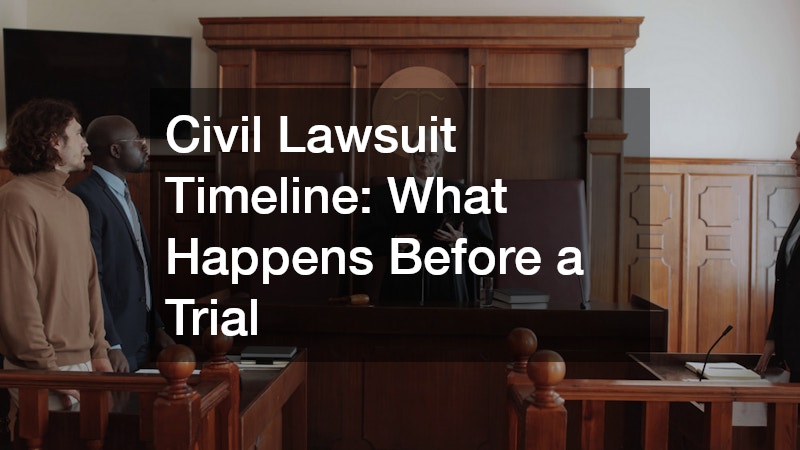Civil lawsuits are often portrayed in media as dramatic courtroom battles where legal teams spar in front of a judge and jury. However, there is a detailed process before these cases reach trial, encompassed by the civil procedure before trial. Understanding this pre-trial journey is essential for those navigating the complex legal landscape.
In this article, we break down the timeline of a civil lawsuit before it reaches the court, highlighting the critical stages that occur before the parties ever step into a courtroom.
Pleadings
The first step in the civil procedure before trial is the pleadings phase, where both parties formally present their claims and defenses. This phase begins when the plaintiff files a complaint with the court, outlining the allegations against the defendant and the legal basis for the lawsuit. The complaint must also include what the plaintiff seeks as a remedy, which can often include monetary compensation or specific actions by the defendant. Once served, the defendant has a specified time frame to file an answer, admitting or denying the allegations and asserting any defenses. This exchange establishes the foundation of the case, outlining the issues that will need resolution, but it does not end the pre-trial process.
After the initial complaint and answer, parties may file additional pleadings, including a counterclaim, cross-claim, or third-party complaint. These pleadings further detail the parties’ positions and often introduce new parties or claims into the lawsuit, complicating the legal landscape. For instance, the defendant might file a counterclaim against the plaintiff, alleging separate damages arising from the same incident. Cross-claims involve additional allegations among co-defendants, while third-party complaints bring outside parties into the lawsuit. These documents guide the discovery process, setting the parameters for what information will be relevant as the parties prepare for a potential trial.
Discovery
Following the pleadings phase, civil procedure before trial moves into discovery, a critical phase where both parties exchange relevant information and evidence. Discovery allows each party to assess the evidence supporting the other’s claims or defenses, promoting fairness by eliminating surprises at trial. This phase includes several methods, such as interrogatories, requests for production of documents, and depositions. Interrogatories are written questions that the opposing party must answer under oath, while requests for production demand documents related to the case. Depositions involve questioning witnesses under oath, with their testimony recorded for later use in court.
The discovery phase can be time-consuming and expensive, often involving extensive document review and substantial back-and-forth between parties. It aims to narrow the issues for trial and enable both parties to craft well-informed litigation strategies. During this phase, disputes often arise over the scope of discovery, with parties seeking to protect sensitive information or oppose burdensome requests. Courts may intervene to resolve these disputes, issuing rulings to ensure compliance and fairness. Discovery is crucial for constructing a strong case, influencing the likelihood of settlement or success in trial.
Pre-Trial Motions
After discovery, the next stage in the civil procedure before trial consists of pre-trial motions, where parties request the court to make decisions on specific issues. These motions can significantly influence the direction and length of a trial, as they address critical legal and factual questions. Common pre-trial motions include motions to dismiss, summary judgments, and motions to exclude evidence. A motion to dismiss argues that the case should not proceed due to legal deficiencies, such as lack of jurisdiction or failure to state a claim. Summary judgment motions contend that no genuine issue of material fact exists, allowing for a decision based on the law without a trial.
Pre-trial motions serve to streamline issues for trial, focusing on the substantive disputes that genuinely require judicial intervention. Courts carefully consider these motions, holding hearings where attorneys present arguments and supporting evidence. Decisions on these motions can reshape the trial landscape, eliminating certain claims or defenses and clarifying the scope of what will be judged in court. Successful pre-trial motions might result in case dismissals or settlements, significantly shortening the litigation process. Hence, they are a powerful tool in civil litigation, often determining the course and resolution of the lawsuit.
The civil procedure before trial is a comprehensive process that significantly shapes the trajectory and outcome of a lawsuit. Understanding the nuances of pleadings, discovery, and pre-trial motions is essential for navigating the judicial system effectively. Each phase offers opportunities for settlement and resolution, often preventing lengthy and expensive courtroom battles. As cases proceed through these pre-trial stages, it’s evident that thorough preparation is key, emphasizing the importance of legal counsel in guiding clients through this complex journey. Ultimately, a well-managed pre-trial process ensures a smoother transition to trial, or better yet, a satisfactory resolution outside of court.
.




